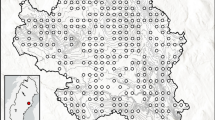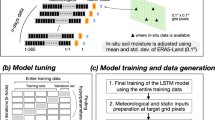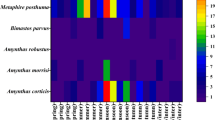Abstract
The effects of environmental quantity (moderate soil moisture vs. low soil moisture) and quality (low soil moisture vs. low temperature) on multilocus heterozygosity (MLH)-growth relationships were tested in the earthworm Eisenia fetida. The control treatment was high soil moisture and high temperature. Fresh weight was measured weekly for 4 weeks; MLH was computed for eight polymorphic loci. Moderate moisture limited growth (change in fresh weight) to 50 per cent of control growth; both low moisture and low temperature limited growth to 25 per cent of control growth. MLH was not correlated with growth at any time in the control treatment. MLH was strongly correlated with growth (P<0.01) in three out of four weekly intervals in the moderate moisture treatment; MLH was weakly correlated with growth (P<0.05) in two out of four weekly intervals in the low moisture treatment. MLH was not correlated with growth at any time in the low temperature treatment. Moderate soil moisture produced significantly stronger MLH-growth relationships than high moisture or low temperature. Even though low soil moisture and low temperature depressed growth to the same extent, the former produced MLH-growth relationships whereas the latter did not. Thus both environmental quantity and quality affected the existence and recurrence of MLH-growth relationships.
Similar content being viewed by others
Article PDF
References
Diehl, W J. 1988. Genetics of carbohydrate metabolism and growth in Eisenia foetida (Oligochaeta: Lumbricidae). Heredity, 61, 379–387.
Diehl, W J, and Biesiot, P M. 1994. Relationships between multilocus heterozygosity and morphometric indices in a population of the deep-sea red crab Chaceon quinquedens (Smith). J Exp Mar Biol Ecol, 182, 237–250.
Diehl, W J, Gaffney, P M, and Koehn, R K. 1986. Physiological and genetic aspects of growth in the mussel Mytilus edulis. I. Oxygen consumption, growth and weight loss. Physiol Zool, 59, 201–211.
Diehl, W J, and Koehn, R K. 1985. Multiple-locus heterozygosity, mortality, and growth in a cohort of Mytilus edulis. Mar Biol, 88, 265–271.
Diehl, W J, and Williams, D L. 1992a. Distributions of polymorphisms among pathways of carbohydrate metabolism in the earthworm Eisenia fetida (Oligochaeta). Comp Biochem Physiol, 101B, 83–90
Diehl, W J, and Williams, D L. 1992b. Interactive effects of soil moisture and food on growth and aerobic metabolism in Eisenia fetida (Oligochaeta). Comp Biochem Physiol, 102A, 179–184
Gaffney, P M. 1990. Enzyme heterozygosity, growth rates, and viability in Mytilus edulis: another look. Evolution, 44, 204–210.
Gaffney, P M, Scott, T M, Koehn, R K, and Diehl, W J. 1990. Interrelationships of heterozygosity, growth rate and heterozygote deficiencies in the coot clam, Mulinia lateralis. Genetics, 124, 687–699.
Garton, D W, Koehn, R K, and Scott, T M. 1984. Multiple-locus heterozygosity and the physiological energetics of growth in the coot clam, Mulinia lateralis, from a natural population. Genetics, 108, 445–455.
Gentili, M R, and Beaumont, A R. 1988. Environmental stress, heterozygosity, and growth rate in Mytilus edulis L. J Exp Mar Biol Ecol, 120, 145–153.
Green, R H, Singh, S M, Hicks, B, and McCuaig, J M. 1983. An arctic intertidal population of Macoma balthica (Mollusca, Pelecypoda): genotypic and phenotypic components of population structure. Can J Fish Aquat Set, 40, 1360–1371.
Hartenstein, R, Neuhauser, E F, and Kaplan, D L. 1979. Reproductive potential of the earthworm Eisenia foetida. Oecologia, 43, 329–340.
Hochachka, P W, and Somero, G N. 1984. Biochemical Adaptation. Princeton University Press, Princeton, NJ.
Houle, D. 1989. Allozyme-associated heterosis in Drosophila melanogaster. Genetics, 123, 789–801.
Hu, Y-P, Lutz, R A, and Vrhenhoek, R C. 1993. Overdominance in early life stages of an American oyster strain. J Hered, 84, 254–258.
Koehn, R K, and Bayne, B L. 1989. Towards a physiological and genetical understanding of the energetics of the stress response. In: Calow, P. and Berry, R. J. (eds) Evolution, Ecology and Environmental Stress, pp. 157–171. Academic Press, London.
Koehn, R K, Diehl, W J, and Scott, T M. 1988. The differential contribution by individual enzymes of glycolysis and protein catabolism to the relationship between hetero- zygosity and growth rate in the coot clam, Mulinia lateralis. Genetics, 118, 121–130.
Koehn, R K, and Shumway, S E. 1982. A genetic/physiological explanation for differential growth rate among individuals of the oyster Crassostrea virginica (Gmelin). Mar. Biol. Lett, 3, 35–42.
Mitton, J B. 1993. Enzyme heterozygosity, metabolism, and developmental stability. Genetica, 89, 47–65.
Mitton, J B, and Grant, M C. 1984. Associations among protein heterozygosity, growth rate, and developmental homeostasis. Ann Rev Ecol Syst, 15, 479–499.
Pasteur, N, Pasteur, G, Bonhomme, R, Catalan, J, and Britton-Davidian, J. 1988. Practical Isozyme Genetics. John Wiley and Sons, New York.
Pecon Slattery, J, Vrijenhoek, R C, and Lutz, R A. 1991. Heterozygosity, growth, and survival of the hard clam, Mercenaria mercenaria, in seagrass vs sandflat habitats. Mar Biol, 111, 335–342.
Reinecke, A J, and Venter, J M. 1987. Moisture preferences, growth and reproduction of the compost worm Eisenia fetida (Oligochaeta). Biol Fert Soils, 3, 135–141.
Rice, W R. 1989. Analyzing tables of statistical tests. Evolution, 43, 223–225.
Rodhouse, P G, and Gaffney, P. 1984. Effect of heterozygosity on metabolism during starvation in the American oyster Crassostrea virginica. Mar Biol, 80, 179–187.
Samollow, P B, and Soule, M E. 1983. A case of stress related heterozygote superiority in nature. Evolution, 37, 646–649.
Scott, T M, and Koehn, R K. 1990. The effect of environmental stress on the relationship of heterozygosity to growth rate in the coot clam Mulinia lateralis (Say). J Exp Mar Biol Ecol, 135, 109–116.
Selander, R K. 1970. Behavior and genetic variation in natural populations. Am Zool, 10, 53–66.
Selander, R K, and Yang, S Y. 1969. Protein polymorphism and genie heterozygosity in a wild population of the house mouse (Mus musculus). Genetics, 63, 653–667.
Sokal, R R, and Rohlf, F J. 1981. Biometry 2nd edn. W. H. Freeman and Co., San Francisco.
Williams, D L, and Diehl, W J. 1992. Interactive effects of soil moisture and food on glycolytic metabolism in Eisenia fetida (Oligochaeta). Comp Biochem Physiol, 102B, 911–917
Zar, J H. 1984. Biostatistical Analysis. Prentice-Hall, Engle-wood Cliffs, NJ.
Zouros, E. 1987. On the relation between heterozygosity and heterosis: an evaluation of the evidence from marine mollusks. Isozymes: Curr Top Biol Med Res, 15, 255–270.
Zouros, E, and Foltz, D W. 1987. The use of allelic isozyme variation for the study of heterosis. Isozymes: Curr Top Biol Med Res, 13, 1–59.
Acknowledgements
We thank Ronn Altig for making useful comments on a draft of this paper. This research was supported by a Sigma Xi Grant-in-Aid of Research to M.C.A. and by NSF grant DEB-9221094 to W.J.D.
Author information
Authors and Affiliations
Rights and permissions
About this article
Cite this article
Audo, M., Diehl, W. Effect of quantity and quality of environmental stress on multilocus heterozygosity-growth relationships in Eisenia fetida (Annelida: Oligochaeta). Heredity 75, 98–105 (1995). https://doi.org/10.1038/hdy.1995.109
Received:
Issue date:
DOI: https://doi.org/10.1038/hdy.1995.109
Keywords
This article is cited by
-
Eco-evolutionary causes and consequences of temporal changes in intratumoural blood flow
Nature Reviews Cancer (2018)
-
Genetic diversity-fitness correlation revealed by microsatellite analyses in European alpine marmots (Marmota marmota)
Conservation Genetics (2006)
-
Ontogenetic change in relative performance of allozyme genotypes influences detection of heterosis in the earthworm Eisenia andrei
Heredity (2005)



